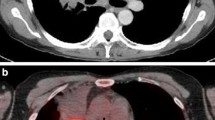Abstract
Drug induced pulmonary toxicity is not uncommon with the use of various chemotherapeutic agents. Cyclophosphamide is a widely used chemotherapeutic drug in the treatment of breast cancer. Although rare, lung toxicity has been reported with cyclophosphamide use. Detection of bleomycin induced pulmonary toxicity and pattern of 18F-fluorodeoxyglucose (18F-FDG) uptake in lungs on fluorodeoxyglucose positron emission tomography-computed tomography (18F-FDG PET-CT) has been elicited in literature in relation to lymphoma. However, limited data is available regarding the role of 18F-FDG PET-CT in monitoring drug induced pulmonary toxicity in breast cancer. We here present two cases of cyclophosphamide induced drug toxicity. Interim 18F-FDG PET-CT demonstrated diffusely increased tracer uptake in bilateral lung fields in both these patients. Subsequently there was resolution of lung uptake on 18F-FDG PET-CT scan post completion of chemotherapy. These patients did not develop significant respiratory symptoms during chemotherapy treatment and in follow up.


Similar content being viewed by others
References
Kazama T, Faria SC, Uchida Y, Ito H, Macapinlac HA. Pulmonary drug toxicity: FDG-PET findings in patients with lymphoma. Ann Nucl Med. 2008;22:111–4.
Kalkanis D, Stefanovic A, Paes F, Escalon MP, Serafini A, Lossos IS. [18F]-fluorodeoxyglucose positron emission tomography combined with computed tomography detection of asymptomatic late pulmonary toxicity in patients with non-Hodgkin lymphoma treated with rituximab-containing chemotherapy. Leuk & Lymphoma. 2009; 50:904–11.
Song BI, Lee SW, Lee HJ, Kang S, Jeong SY, Seo JH et al. Rituximab-induced pneumonitis on F-18 FDG PET/CT in patient with non-Hodgkin lymphoma. Clin Nucl Med. 2010;35:601–3.
Cooper JA Jr, White DA, Matthay RA. Drug-induced pulmonary disease. Part 1: cytotoxic drugs. Am Rev Respir Dis. 1986;133:321–40.
Cooper JA Jr, White DA, Matthay RA. Drug-induced pulmonary disease. Part 2: noncytotoxic drugs. Am Rev Respir Dis. 1986;133:488–505.
Dimopoulou I, Bamias A, Lyberopoulos P, Dimopoulos MA. Pulmonary toxicity from novel antineoplastic agents. Ann Oncol. 2006;17:372–9.
Trisolini R, Lazzari Agli L, Tassinari D, Rondelli D, Cancellieri A, Patelli M et al. Acute lung injury associated with 5-fluorouracil and oxaliplatin combined chemotherapy. Eur Respir J. 2001;18:243–5.
Malik SW, Myers JL, DeRemee RA, Specks U. Lung toxicity associated with cyclophosphamide use. Two distinct patterns. Am J Respir Crit Care Med. 1996;154:1851–6.
Rossi SE, Erasmus JJ, McAdams HP, Sporn TA, Goodman PC. Pulmonary drug toxicity: radiologic and pathologic manifestations. Radiographics. 2000;20:1245–9.
Camus P, Fanton A, Bonniaud P, Camus C, Foucher P. Interstitial lung disease induced by drugs and radiation. Respiration. 2004;71:301–26.
Vahid B, Marik PE. Pulmonary complications of novel antineoplastic agents for solid tumors. Chest. 2008;133:528–38.
Sleijfer S. Bleomycin-induced pneumonitis. Chest. 2001;120:617–24.
Wagnerae T. Diffuse pulmonary uptake on FDG-PET with normal CT diagnosed as intravascular large B-cell lymphoma: a case report and a discussion of the causes of diffuse FDG uptake in the lungs. Cancer Imaging. 2012; 12:7–12.
Groves AM, Win T, Screaton NJ, Berovic M, Endozo R, Booth H et al. Idiopathic pulmonary fibrosis and diffuse parenchymal lung disease: implications from initial experience with 18F-FDG PET/CT. J Nucl Med. 2009;50:538–45.
Prakash P, Kalra MK, Sharma A, Shepard JA, Digumarthy SR. FDG PET/CT in assessment of pulmonary lymphangitic carcinomatosis. AJR Am J Roentgenol. 2010;194:231–6.
Yu JQ, Kumar R, Xiu Y, Alavi A, Zhuang H. Diffuse FDG, uptake in the lungs in aspiration pneumonia on positron emission tomographic imaging. Clin Nucl Med. 2004;29:567–8.
Rodrigues RS, Miller PR, Bozza FA, Marchiori E, Zimmerman GA, Hoffman JM et al. FDG-PET in patients at risk for acute respiratory distress syndrome: a preliminary report. Intensive Care Med. 2008;34:2273–8.
Author information
Authors and Affiliations
Corresponding author
Ethics declarations
Conflict of Interest
Authors Sameer Kamalakar Taywade, Chandrasekhar Bal and Rakesh Kumar declare that they have no conflict of interest.
The manuscript has not been published before or is not under consideration for publication anywhere else and has been approved by all co-authors.
Ethical Statement
Manuscript contains a statement that the study was approved by an institutional review board or equivalent and has been performed in accordance with the ethical standards laid down in the 1964 Declaration of Helsinki and its later amendments. All subjects in the study gave written informed consent or the institutional review board waived the need to obtain informed consent.
Rights and permissions
About this article
Cite this article
Taywade, S.K., Kumar, R., Bhethanabhotla, S. et al. Role of 18F-FDG PET-CT in Monitoring the Cyclophosphamide Induced Pulmonary Toxicity in Patients with Breast Cancer — 2 Case Reports. Nucl Med Mol Imaging 50, 261–265 (2016). https://doi.org/10.1007/s13139-015-0388-3
Received:
Revised:
Accepted:
Published:
Issue Date:
DOI: https://doi.org/10.1007/s13139-015-0388-3




